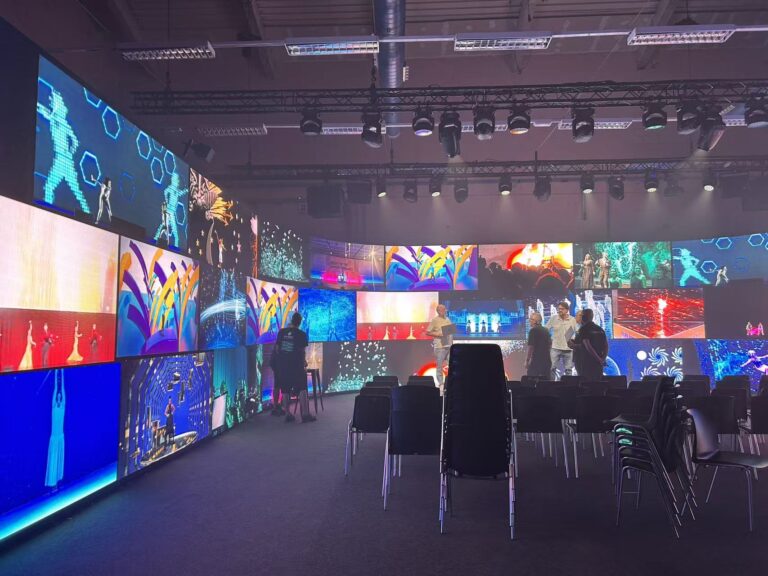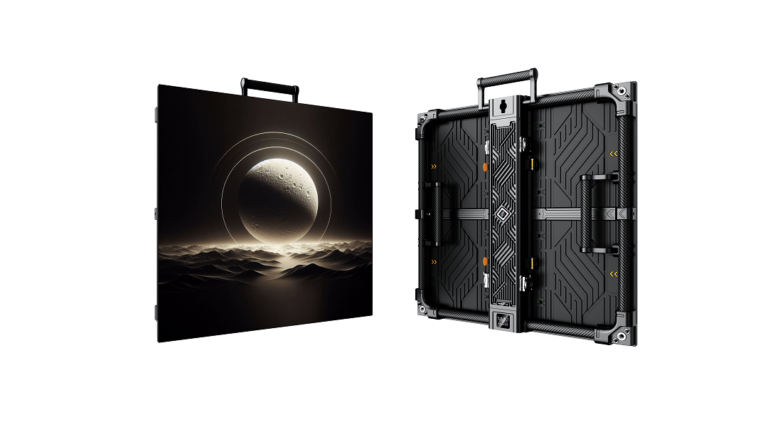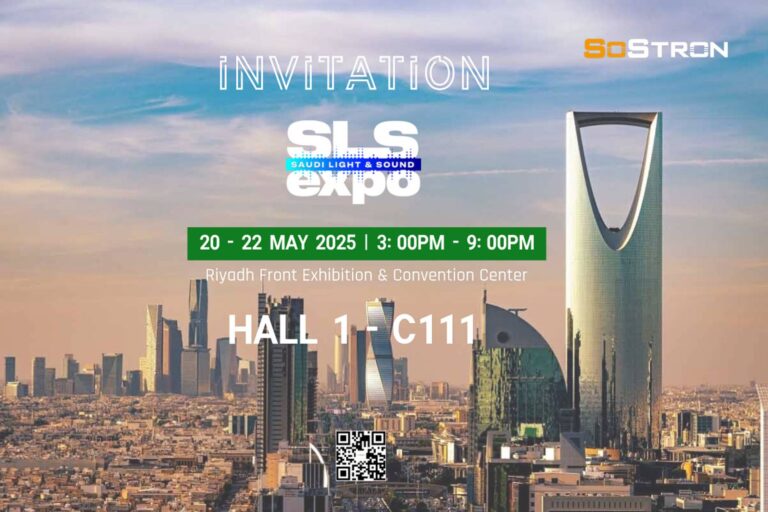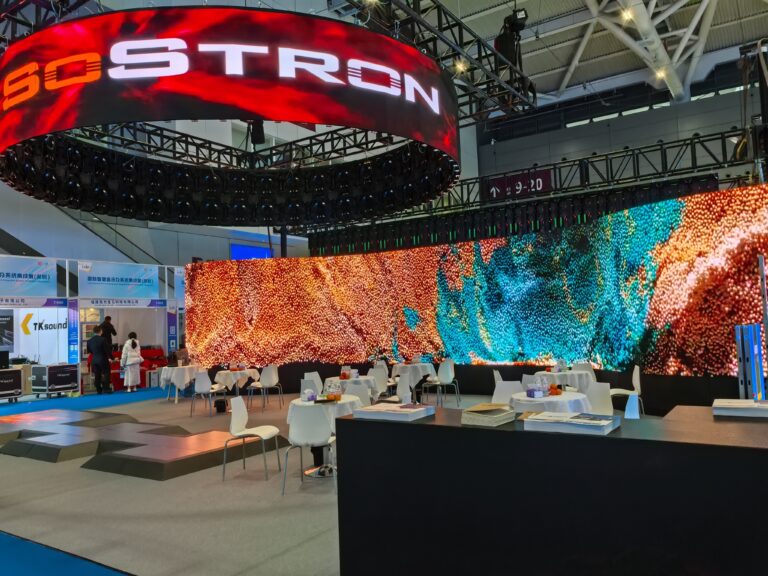Catalog
What is the stage led display?
What is the role of stage led display?
What is the difference between LED stage screen and traditional LED display screen?
How many parts does the stage LED display screen consist of?
Mainstream stage LED display construction scheme
Introducing SoStron’s stage LED display-Hima
With the development of LED technology, LED full-color display has already broken the traditional form. From the first large-area screen, the form of main screen and side screen appeared, and then gradually developed into the innovation of panoramic video wall and creative display, and then to the new manifestation of VR/AR, 3D, holographic projection and other black technologies.
Nowadays, in stage performances, a large LED display screen is often installed as the background wall and playback screen, which is indispensable in stage performances. Today’s stage screens are basically using stage led screens. This LED display has many advantages and is cheap, so it is widely used.
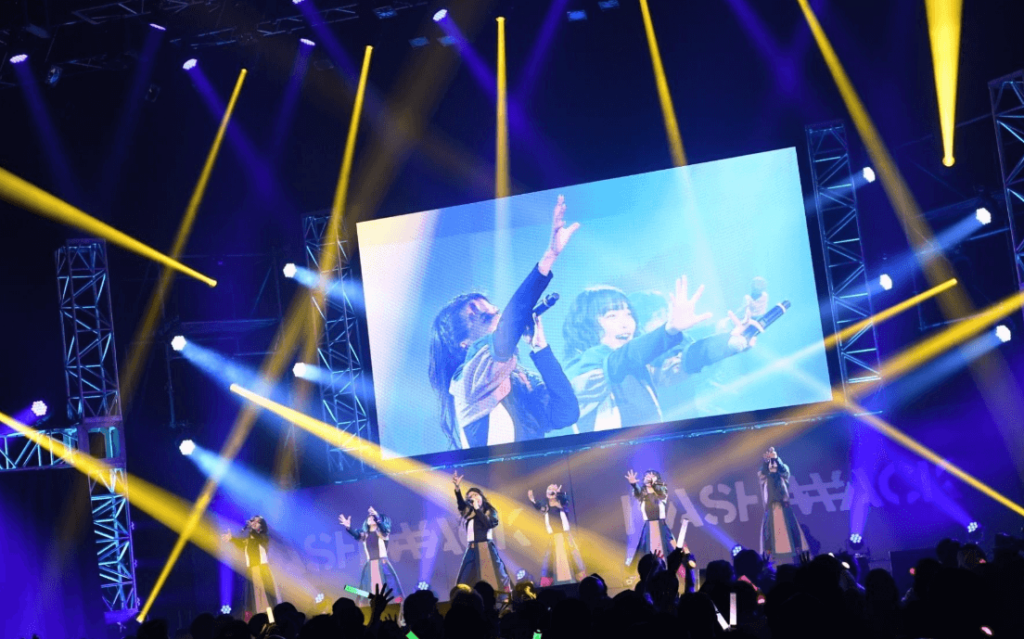
What are Stage LED Screens?
Stage LED large screens can divide a picture into multiple video sections for broadcasting. These screens can be used independently or combined to display relevant backgrounds. They offer versatility in displaying different areas according to performance requirements, allowing for picture and text superposition. Stage LED screens are convenient, reliable, and widely applied in various large entertainment venues. Curious about LED stage rental screen prices?
Roles of Stage LED Screens:
- Enrich Performance Content:
LED screens have evolved from simple video displays to enriching stage performances. They provide more than just synchronized video images, adding depth to performance content and offering audiences additional information and visual experiences.
- Create Associations and Atmosphere:
LED screens play a vital role in stage art, moving beyond traditional scenery. They replace static sets with dynamic visuals, creating associations and enhancing the atmosphere. Virtual images stimulate imagination and contribute more to the ambiance than physical scenery.
- Versatility and Flexibility:
LED screens offer unparalleled variety and flexibility in picture transformation. They can instantly switch between dynamic, static, realistic, abstract, and colorful visuals. LED technology enables vivid and dynamic displays, surpassing the limitations of traditional scenery.
Stage LED screens have become integral to modern stage performances, offering dynamic visuals and enhancing audience engagement.
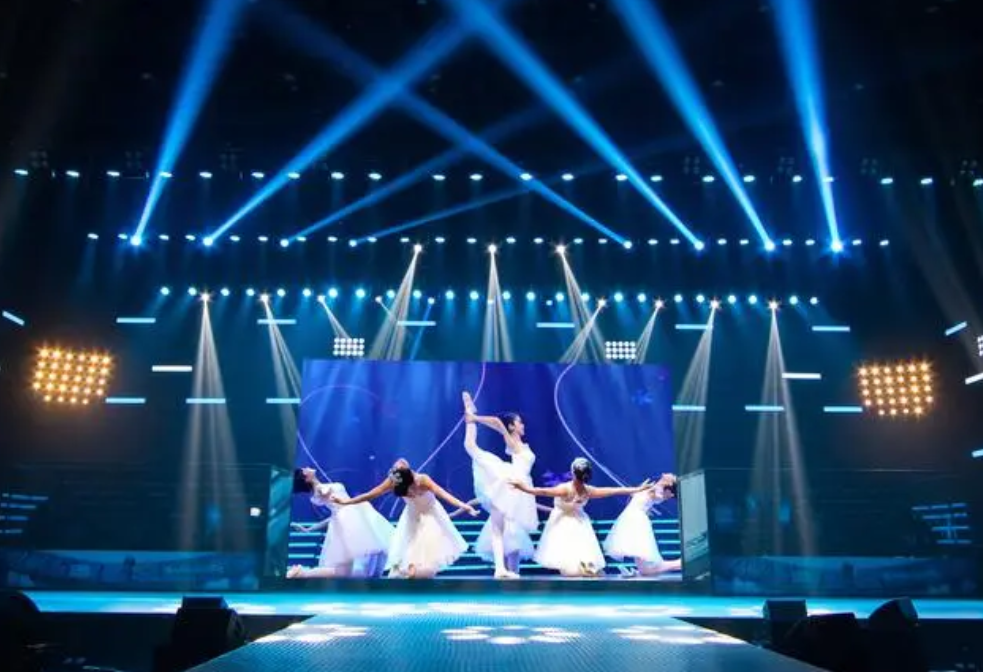
What is the difference between LED stage screen and traditional LED display screen?
1. Different models
Because the LED stage screen has a high display of dance beauty, the screen playback effect is required to be clearer. Therefore, the P3 P4 HD screen is generally used in the indoor environment, and the small spacing P2.5 P2 is even more severe, and the P6 P5 model is used outdoors. The traditional indoor and outdoor LED display screens, due to the long viewing distance or low display requirements, generally use P5 P4 indoor, P10 is the most used outdoor, followed by P16.
2. Installation method
As mentioned earlier, the removal and installation of LED stage screen is convenient and fast. For example, after a concert, it can be removed and transported to another stage for construction. However, the traditional indoor and outdoor LED display screen is usually fixed. After the installation position is fixed, it will not move easily.
3. Box difference
The traditional outdoor LED display screen and the box will be waterproof, and the structure is relatively heavy. LED simple box for indoor use; The stage LED rental display screen is usually made of die-cast aluminum box because the box is often disassembled and moved.
How many parts does the stage LED display screen consist of?
1. The main screen is the screen at the center of the stage. Most of the time, the main screen is shaped like a square or rectangle. Because of the importance of the content it displays, the pixel density of the main screen is relatively high. At present, the main display specifications for the main screen are P4, P5 and P6.
2. The secondary screen is the display screen on both sides of the main screen. Its main purpose is to set off the main screen, so the content it displays is relatively abstract. Therefore, the models used are relatively large. At present, the commonly used specifications mainly include P7.62, P8, P10, P12 and P16, and in the process of use, the grid LED display screen is often used.
3. Video expansion screen is mainly used in relatively large occasions, such as large-scale concerts, singing and dancing concerts, etc. In these occasions, because the venue is relatively large, there are many places where people and effects on the stage cannot be clearly seen, so one or two large screens are set at the side of these venues. Its content is generally live broadcast on the stage. Now the commonly used specifications are similar to the main screen. P4, P5 and P6 LED displays are used more frequently.
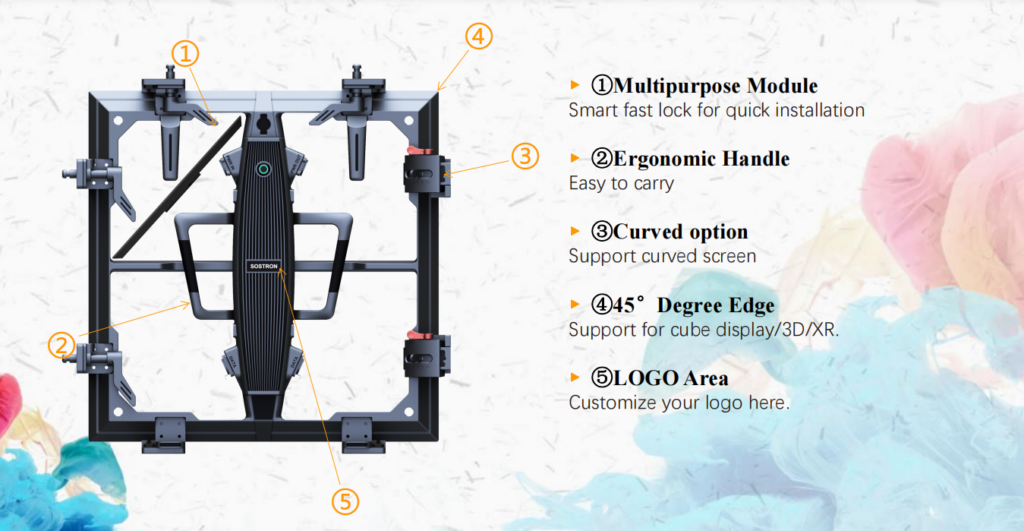
Mainstream Stage LED Display Construction Schemes
Scheme 1: Steel Structure Stage with LED Large Screen
The stage combined with a robust LED large screen ensures stability and safety due to the stage’s better weight-bearing capacity. Flexibility in switching pictures and playing videos enhances the colorful elements of stage backgrounds.
Scheme 2: Enhanced Stage with LED Large Screen and Color Screen
Integrating a brilliant LED large screen and color screens amplifies the visual impact. Flexible content switching allows for dynamic elements such as theme pictures, videos, live broadcasts, and interactive materials, enhancing the atmosphere and engagement of the event.
Scheme 3: Multi-dimensional Stage with LED Large Screen and Color Screen
T-shaped and round stages add depth and interaction to the performance space, bringing the audience closer and facilitating engagement. Flexibility in content display enriches stage backgrounds with colorful elements and dynamic visuals.
The use of LED large screens in stage performances has revolutionized the visual experience. From live broadcasts to special effects and interactive elements, LED screens elevate performances to new heights. Lifelike imagery, combined with captivating music, creates a modern and magnificent atmosphere. Clear live video feeds immerse the audience in an unforgettable audio-visual spectacle.
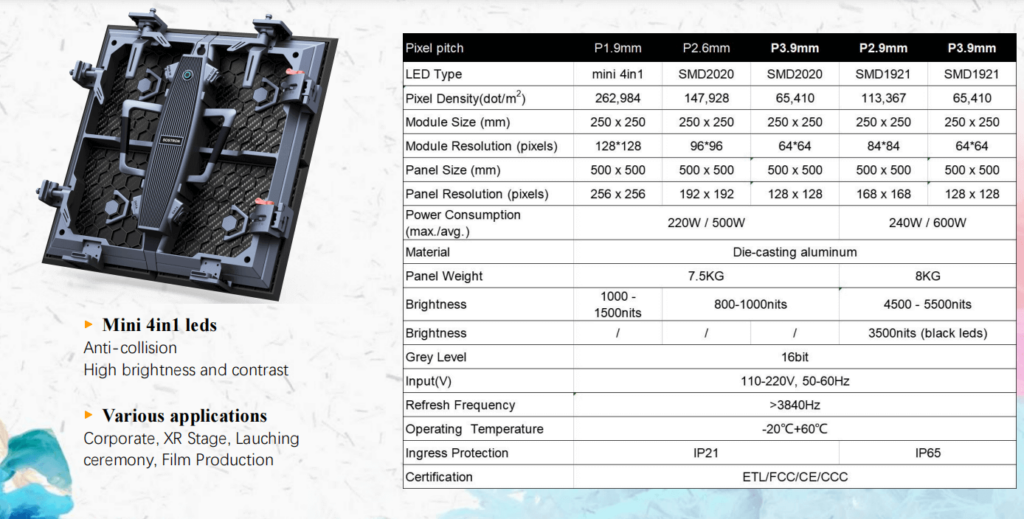
Introducing SoStron’s stage LED display-Hima
Stage LED display-Hima has impressive innovative features that add more fun and interactivity to your events. The 90° installation design and 45° angle-cut cabinet give the screen more creative design and viewing angles, presenting a more engaging experience for the audience. Whether it is a ground screen or a ground screen + interactive equipment, it can make your event more exciting and stimulate the audience’s enthusiasm for participation.
Not only does this screen offer excellent mobility, it also uses state-of-the-art technology in terms of materials and manufacturing. The aluminum material using die-casting technology not only enables rapid mass production, but also ensures the flatness and positional accuracy of the cabinet, making the entire screen seamlessly connected and ensuring perfect presentation of visual effects.
In terms of size and weight, the compact size of 500*500 mm, combined with the built-in handle, makes it easy to hold and does not take up installation space. This feature makes the screen very flexible when hosting parties or events, inspiring inspiration and creating more creative interactive experiences. Whether it is displaying content or event planning, this movable conference screen can definitely add more creativity and vitality.
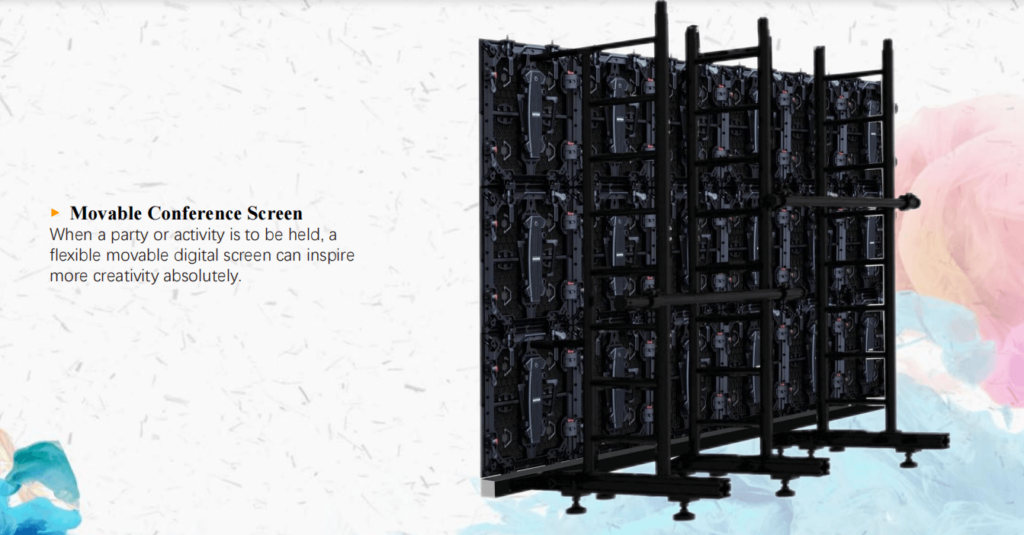
The following are the parameters of the rental display-Hima
| Pixel pitch (mm) | 1.9 | 2.6 | 2.9 | 3.9 |
|---|---|---|---|---|
| LED | mini 4in1 | SMD2020 | SMD1921 | (SMD1921/SMD2020) |
| Density (dots/sqm) | 277008 | 147929 | 118906 | 65746 |
| Module resolution (dots) | 17313 | 9246 | 7432 | 4109 |
| Module width (mm) | 250 | 250 | 250 | 250 |
| Module height (mm) | 250 | 250 | 250 | 250 |
| Cabinet width (mm) | 500 | 500 | 500 | 500 |
| Cabinet height (mm) | 500 | 500 | 500 | 500 |
| Cabinet depth | 75 | 75 | 75 | 75 |
| Resolution (dots) | 69252 | 36982 | 29727 | 16437 |
| Weight (kg) | 7.5 | 7.5 | 7.5 | (8/7.5) |
| Material | Die-casting aluminium | Die-casting aluminium | Die-casting aluminium | Die-casting aluminium |
| Maintain | Front rear | Front rear | Front rear | Front rear |
| IPX | IP43 | IP43 | IP65 | IP65 |
| Max brightness (cd/sqm) | 1500 | 1000 | 1000 | (5500/1000) |
| Color temperature (k) | 6500 | 6500 | 6500 | 6500 |
| Angle | 160/160 | 160/160 | 160/140 | 160/140 |
| Contrast ratio | 5000:1 | 5000:1 | (5000:1/4000:1) | (5000:1/5000:1/4000:1/4000:1) |


